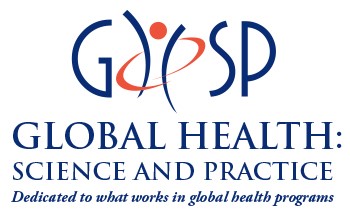More articles from ORIGINAL ARTICLE
- Increasing Access to Family Planning Choices Through Public-Sector Social Franchising: The Experience of Marie Stopes International in Mali
While social franchising has been highly successful with private-sector providers, in Mali the approach was expanded to public-sector community health clinics. From 2012 to 2015, these clinics served >120,000 family planning clients, 78% of whom chose long-acting reversible methods. Many clients were young, poor, and had not been using a method during the 3 months prior to their visit.
- Improving Adherence to Essential Birth Practices Using the WHO Safe Childbirth Checklist With Peer Coaching: Experience From 60 Public Health Facilities in Uttar Pradesh, India
Implementation of the WHO Safe Childbirth Checklist with peer coaching resulted in >90% adherence to 35 of 39 essential birth practices among birth attendants after 8 months, but adherence to some practices was lower when the coach was absent.
- Availability and Quality of Family Planning Services in the Democratic Republic of the Congo: High Potential for Improvement
A few facilities provided good access to and quality of family planning services, particularly urban, private, and higher-level facilities. Yet only one-third offered family planning services at all, and only 20% of these facilities met a basic measure of quality. Condoms, oral contraceptives, and injectables were most available, whereas long-acting, permanent methods, and emergency contraception were least available. Responding to the DRC's high unmet need for family planning calls for substantial expansion of services.
- Effect on Neonatal Mortality of Newborn Infection Management at Health Posts When Referral Is Not Possible: A Cluster-Randomized Trial in Rural Ethiopia
Health Extension Workers (HEWs), in general, properly provided antibiotic treatment of possible severe bacterial infections in newborns at the health post level. But only about half of newborns estimated to have infections in the intervention area received treatment by HEWs, and home visits and referrals declined in the final months of the study. Cluster-level analysis suggests a mortality reduction consistent with this level of treatment coverage, although the finding did not reach statistical significance.
- Limited Service Availability, Readiness, and Use of Facility-Based Delivery Care in Haiti: A Study Linking Health Facility Data and Population Data
Proximity to a health facility offering delivery services and readiness of the facilities to provide such services were poor in both rural and urban areas outside of Port-au-Prince. Availability of a proximate facility was significantly associated with women in rural and urban areas delivering at a facility, as was the quality of delivery care available at the facilities but only in urban areas.
- Benefits and Limitations of Text Messages to Stimulate Higher Learning Among Community Providers: Participants' Views of an mHealth Intervention to Support Continuing Medical Education in Vietnam
The original intention was to deliver technical content through brief text messages to stimulate participants to undertake deeper learning. While participants appreciated the convenience and relevance of the text messages, their scores of higher-order knowledge did not improve. The intervention may not have been successful because the messages lacked depth and interactivity, and participants were not explicitly encouraged to seek deeper learning.
- The BetterBirth Program: Pursuing Effective Adoption and Sustained Use of the WHO Safe Childbirth Checklist Through Coaching-Based Implementation in Uttar Pradesh, India
The BetterBirth Program relied on carefully structured coaching that was multilevel, collaborative, and provider-centered to motivate birth attendants to use the WHO Safe Childbirth Checklist and improve adherence to essential birth practices. It was scaled to 60 sites as part of a randomized controlled trial in Uttar Pradesh, India.
- Youth Voucher Program in Madagascar Increases Access to Voluntary Family Planning and STI Services for Young People
Program accomplishments during the first 18 months:
More than 58,000 free vouchers distributed to young people, of which 74% were redeemed.
79% chose long-acting reversible contraceptives (LARCs) and 51% received STI counseling.
Client profile data snapshot:
69% had never previously used contraception and 96% were 20 or younger.
- Community Health Workers as Social Marketers of Injectable Contraceptives: A Case Study from Ethiopia
Volunteer community health workers (CHWs) administered injectable contraceptives to women in the community for a small fee while providing counseling and referrals for other methods. Over nearly 3 years, more than 600 CHWs provided an estimated 15,410 injections. The model has the potential to improve sustainability of community-based distribution programs by incorporating social marketing principles to partially recover commodity costs and compensate CHWs.
- A Non–Gas-Based Cryotherapy System for the Treatment of Cervical Intraepithelial Neoplasia: A Mixed-Methods Approach for Initial Development and Testing
A non–gas-based treatment device for early cervical cancer treatment, adapted for use in low-resource settings to improve ease of use, portability, and durability, performed similarly to a standard gas-based cryotherapy device in small-scale testing. A large randomized clinical trial is currently underway for further assessment.

